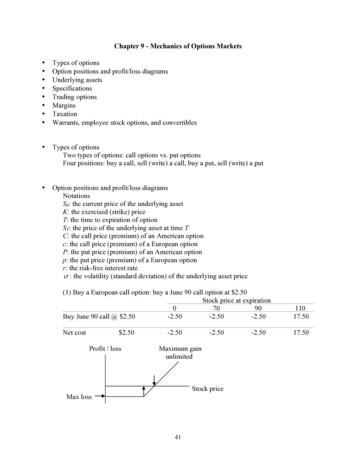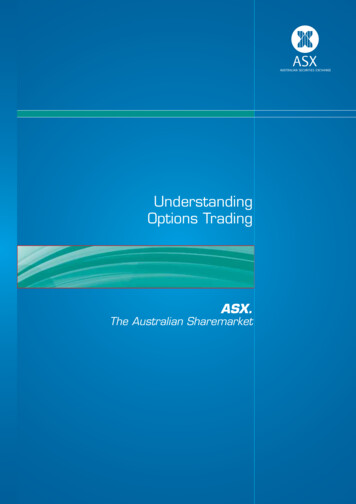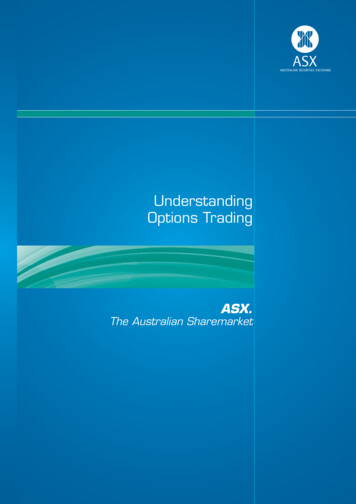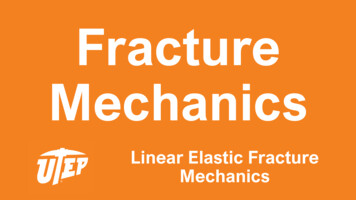
Transcription
Chapter 9 - Mechanics of Options Markets Types of optionsOption positions and profit/loss diagramsUnderlying assetsSpecificationsTrading optionsMarginsTaxationWarrants, employee stock options, and convertibles Types of optionsTwo types of options: call options vs. put optionsFour positions: buy a call, sell (write) a call, buy a put, sell (write) a put Option positions and profit/loss diagramsNotationsS0: the current price of the underlying assetK: the exercised (strike) priceT: the time to expiration of optionST: the price of the underlying asset at time TC: the call price (premium) of an American optionc: the call price (premium) of a European optionP: the put price (premium) of an American optionp: the put price (premium) of a European optionr: the risk-free interest rateσ : the volatility (standard deviation) of the underlying asset price(1) Buy a European call option: buy a June 90 call option at 2.50Stock price at expiration07090Buy June 90 call @ 2.50-2.50-2.50-2.5011017.50Net cost17.50 2.50Profit / loss-2.50-2.50Maximum gainunlimitedStock priceMax loss41-2.50
Write a European call option: write a June 90 call at 2.50 (exercise for students, reversethe above example)Buy a European put option: buy a July 85 put at 2.00Stock price at expiration06585Buy June 85 put @ 2.0083.0018.00-2.00105-2.00Net cost-2.00 2.0083.0018.00-2.00Profit / lossMax gainStock priceMax lossWrite a European put option: write a July 85 put at 2.00 (exercise for students, reversethe above example)In general, the payoff at time T:(1) For a long European call option is max (ST - K, 0)(2) For a short European call option is min (K - ST, 0) -max (ST - K, 0)(3) For a long European put option is max (K - ST, 0)(4) For a short European put option is min (ST - K, 0) -max (K - ST, money options: S K for calls and S K for putsOut-of-the-money options: S K for calls and S K for putsAt-the-money options: S K for both calls and puts42STST(4)
Intrinsic value max (S - K, 0) for a call optionIntrinsic value max (K - S, 0) for a put optionC (or P) intrinsic value time valueSuppose a June 85 call option sells for 2.50 and the market price of the stock is 86,then the intrinsic value 86 – 85 1; time value 2.50 - 1 1.50Suppose a June 85 put option sells for 1.00 and the market price of the stock is 86, thenthe intrinsic value 0; time value 1 - 0 1Naked call option writing: the process of writing a call option on a stock that the optionwriter does not ownNaked options vs. covered options Underlying assetsIf underlying assets are stocks - stock optionsIf underlying assets are foreign currencies - currency optionsIf underlying assets are stock indexes - stock index optionsIf underlying assets are commodity futures contracts - futures optionsIf the underlying assets are futures on fixed income securities (T-bonds, T-notes) interest-rate options SpecificationsDividends and stock splits: exchange-traded options are not adjusted for cash dividendsbut are adjusted for stock splitsPosition limits: the CBOE specifies a position limit for each stock on which options aretraded. There is an exercise limit as well (equal to position limit)Expiration date: the third Friday of the month Trading optionsMarket maker system (specialist) and floor brokerOffsetting orders: by issuing an offsetting orderBid-offer spreadCommissions43
MarginsWriting naked options are subject to margin requirementsThe initial margin for writing a naked call option is the greater of(1) A total of 100% of proceeds plus 20% of the underlying share price less the amount,if any, by which the option is out of the money(2) A total of 100% of proceeds plus 10% of the underlying share priceThe initial margin for writing a naked put option is the greater of(1) A total of 100% of proceeds plus 20% of the underlying share price less the amount,if any, by which the option is out of the money(2) A total of 100% of proceeds plus 10% of the exercise priceFor example, an investor writes four naked call options on a stock. The option price is 5,the exercise price is 40, and the stock price is 38. Because the option is 2 out of themoney, the first calculation gives 400*(5 0.2*38-2) 4,240 while the secondcalculation gives 400*(5 0.1*38) 3,520. So the initial margin is 4,240.If the options were puts, it would be 2 in the money. The initial margin from the firstcalculation would be 400*(5 0.2*38) 5,040 while it would be 400*(5 0.1*40) 3,600 from the second calculation. So the initial margin would be 5,040.Buying options requires cash payments and there are no margin requirementsWriting covered options are not subject to margin requirements (stocks as collateral) TaxationIn general, gains or losses are taxed as capital gains or losses. If the option is exercised,the gain or loss from the option is rolled over to the position taken in the stock.Wash sale rule: when the repurchase is within 30 days of the sale, the loss on the sale isnot tax deductible Warrants, employee stock options, and convertiblesWarrants are options issued by a financial institution or a non-financial corporation.Employee stock options are call options issued to executives by their company tomotivate them to act in the best interest of the company’s shareholders. Convertiblebonds are bonds issued by a company that can be converted into common stocks. AssignmentsQuiz (required)Practice Questions: 9.9, 9.10 and 9.1244
Chapter 10 - Properties of Stock Options Factors affecting option pricesUpper and lower bounds for option pricesPut-call parityEarly exerciseEffect of dividends Factors affecting option pricesSix factors:Current stock price, S0Strike (exercise) price, KTime to expiration, TVolatility of the stock price, σRisk-free interest rate, rDividends expected during the life of the optionRefer to Table 10.1VariablesStock priceStrike priceTime to expirationVolatilityRisk-free rateDividendsEuropean call n/a -European put n/a American call -American put Refer to Figures 10.1 and 10.2 indicates that two variables have a positive relationship (partial derivative is positive)- indicates that two variables have a negative relationship (partial derivative is negative) Upper and lower bounds for options pricesUpper bounds for calls: c S0 and C S0If the condition is violated, arbitrage exists by buying the stock and writing the callUpper bounds for puts: p K and P KFor European put options, it must be: p Ke-rTIf the condition is violated, arbitrage exists by writing the put and investing the proceedsat the risk-free rateLower bound for European calls on nondividend-paying stocks: c S0 - Ke-rTLower bound for American calls on nondividend-paying stocks: C S0 - Ke-rTIf the condition is violated, arbitrage exists by buying the call, shorting the stock, andinvesting the proceeds45
Lower bound for European puts on nondividend-paying stocks: p Ke-rT - S0Lower bound for American puts on nondividend-paying stocks: P K - S0If violated, arbitrage exists by borrowing money and buying the put and the stock Put -call parityConsiders the relationship between p and c written on the same stock with same exerciseprice and same maturity datePortfolio A: buy a European call option at ct and invest Ke-rTStock price at expirationPortfolio AST KST ------------------------------------------Buy call @ ctST - K0Invest -----------------NetSTKPortfolio B: buy a European put option at pt and buy one share of stock StStock price at expirationPortfolio BST KST ------------------------------------------Buy put @ p0K - STBuy stock at STKSince two portfolios are worth the same at expiration, they should have the same value(cost) today. Therefore, we have the put-call parity for European optionsorArbitrage exists if the parity does not holdct Ke r (T t ) pt S tc Ke rT p S 0 if t 0 for todayExampleYou are interested in XYZ stock options. You noticed that a 6-month 50 call sells for 4.00, while a 6-month 50 put sells for 3.00. The 6-month interest rate is 6%, and thecurrent stock price is 48. There is an arbitrage opportunity present. Show how you cantake the advantage of it.Answer:c Ke-rT 4 50 e-0.06 (0.5) 52.52p S0 3 48.00 51.00Arbitrage opportunity exists with a risk-free profit of 1.5246
Rationale: the stock and put are undervalued relative to the callStock Price at expirationIf ST 50If ST ------------Write a 50 call @4.00(50 - ST )0Borrow 48.52 (present value of 50)48.52- 50- ------------Buy a share @ 48.00- 48.00STSTBuy a 50 put @ 3.00- 3.000(50 - -------------Net 1.5200Put-call parity for American options: S 0 K C P S 0 Ke rT Early exerciseFor American call optionsNondividend-paying stocks: never early exercise(1) You can always sell the call at a higher price (intrinsic value time value)(2) Insurance reason (what if the stock price drops after you exercise the option?)Dividend-paying stocks: early exercise may be optimal if dividends are large enoughFor American put optionsNondividend-paying stocks: early exercise can be optimal if the option is deep in-themoney Effect of dividendsAdjust for dividends (D is the present value of cash dividends)Lower bonds for calls with adjustments of dividends: c (S0 - D) - Ke-rTLower bonds for puts with adjustments of dividends: p Ke-rT - (S0 - D)Since dividends lower the stock price, we use the adjusted stock price, (S0 - D) in the putcall parity. For stocks that pay dividends the put-call parity for European and Americanoptions can be written respectively asc K rT p ( S 0 D) and( S 0 D) K C P S 0 Ke rTAssignmentsQuiz (required)Practice Questions: 10.9, 10.10, 10.11 and 10.1247
Chapter 11 - Trading Strategies Involving Options Strategies with a single option and a stockSpreadsCombinations Strategies with a single option and a stockA strategy involves an option and the underlying stockStrategy (1) - Long a stock and write a call (writing a covered call)Example: buy a stock at 86 and write a Dec. 90 call on the stock at 2.00Buy stock @86Write Dec. 90 call @ 2Net-84Profit/lossStock price at expiration4590-41422-3960-862-8413549-436Max gainStock priceMax loss(1) Long a stock write a call write a putStrategy (2) - Short a stock and buy a callExample: short a stock at 86 and buy a Dec. 90 call on the stock at 2.00(2) Short a stock buy a call buy a put (exercise for students, reverse strategy 1)Strategy (3) - Long a stock and buy a put (protective put)Example: buy a stock at 86 and buy a Dec. 85 put on the stock at 2.00Buy stock @86Buy Dec. 85 put @ 2Net-88Stock price at expiration4585-41-138-2-3-30-8683-34812539-237
Profit/lossMax gainStock priceMax loss(3) Long a stock buy a put buy a callStrategy (4) - Short a stock and write a putExample: short a stock at 86 and write a Dec. 85 put on the stock at 2.00(4) Short a stock write a put write a call (exercise for students, reverse strategy 3) SpreadsA spread involves a position in two or more options of the same typeBull spreads: buy a call on a stock with a certain strike price and sell a call on the samestock with a higher strike priceExample: buy a Dec. 85 call at 3 and write a Dec. 90 call at 1.00Buy Dec. 85 call @ 3Write Dec. 90 call @ 1Net-2Stock price at /lossMax gainStock priceMax lossWhy bull spreads: you expect that the stock price will go upBear spreads: buy a call on a stock with a certain strike price and sell a call on the samestock with a lower strike priceExample: write a Dec. 85 call at 3 and buy a Dec. 90 call at 1 (reverse the bull spread)Why bear spreads: you expect that the stock price will go down49
Butterfly spreads: involve four options (same type) with three different strike pricesExample: buy a Dec. 80 call at 7.00, write 2 Dec. 85 calls at 3.00, and buy a Dec. 90call at 1.00Stock price at expiration458085-7-7-2666-1-1-1-2-230-76-1-2Buy a Dec. 80 call @ 7Write 2 Dec. 85 calls @ 3Buy a Dec. 90 call @ 1Net-2Profit/loss903-4-1-212538-7434-2Max gainStock priceMax lossWhy butterfly spreadsOther spreads: calendar spreads, diagonal spreads, etc CombinationsA combination involves a position in both calls and puts on the same stockStraddle: involves buying a call and a put with the same strike price and expiration dateExample: long a Dec. 85 straddle by buying a Dec. call at 3.00 and a Dec. put at 2.00Buy Dec. 85 call @ 3Buy Dec. 85 put @ 2Net-5Profit/lossMax gainStock price at expiration4585-3-338-235-50-38380Max gainMax lossStock priceWhy straddle5012537-235
Strangle: involves buying a put and a call with same expiration date but different strikepricesExample: long a Dec. Strangle by buying a Dec. 90 call at 2.00 and a Dec. 85 put at 3.00Buy Dec. 85 put @ 3Buy Dec. 90 call @ 2Net-5Profit/lossMax gain082-2804537-235Stock price at expiration8590-3-3-2-2-5-5Max gainStock priceMax lossWhy strangleStrips and straps: different numbers of calls and puts AssignmentsQuiz (required)Practice Questions: 11.10 and 11.1251130-33835
Chapter 12 - Binomial Option Pricing Model A one-step binomial modelRisk-neutral valuationTwo-step binomial modelMatching volatility with u and dOptions on other assets One-step binomial modelA numerical examp
the exercise price is 40, and the stock price is 38. Because the option is 2 out of the money, the first calculation gives 400*(5 0.2*38-2) 4,240 while the second calculation gives 400*(5 0.1*38) 3,520. So the initial margin is 4,240. If the options were puts, it would be 2 in the money. The initial margin from the first











